



Overview Of The US Cattle Industry
The Overview of the United States Cattle Industry report provides an official periodic review of changes in the United States cattle industry and its impact on cattle supplies and disposition. Produced by the USDA NASS.General
Cattle production is one of the most important industries in the United States, representing 43.8 billion in cash receipts during 2009. Modern beef production in the United States is a highly specialized system that spans from cow-calf operators that typically graze pastureland to cattle feedlots focusing on finishing cattle on grain for slaughter. The Overview of the United States Cattle Industry report provides an official periodic review of changes in the United States cattle industry and its impact on cattle supplies and disposition. Additionally, this report gives a brief overview of survey and estimation procedures as well as terminology used in NASS cattle publications.
United States Cattle Operations Decline
The structure of the United States cattle industry continues to change, with a greater proportion of cattle being raised on fewer and larger farms. The total number of cattle operations in the United States was 950,000 for 2009, down 1 percent from 2008. Beef cow operations in 2009, at 753,000 were also down 1 percent from 2008. During the last 20 years, the number of all cattle operations in the United States has fallen 28 percent, while beef cow operations have declined by 21 percent (Graph 1).
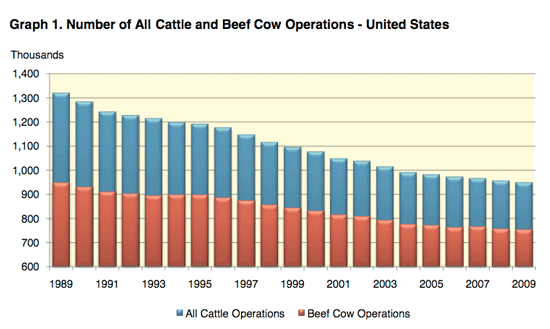
Over this time, the average number of cattle per operation has increased by 36 percent to nearly 100 head on total cattle operations (Graph 2).
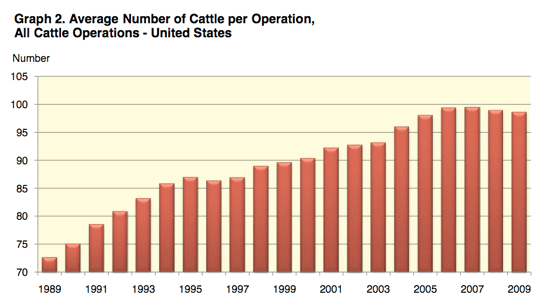
In 2009, operations with 500 or more head accounted for 47.7 percent of the total cattle inventory, compared with only 38.0 percent in 1999 (Graph 3).
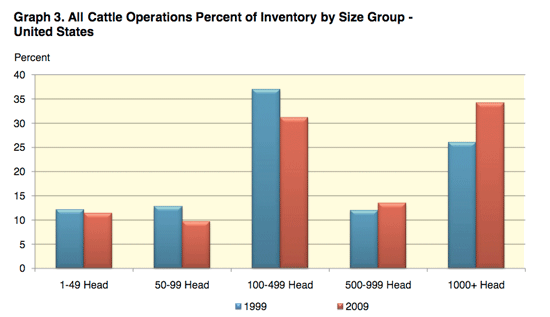
Although less pronounced, the percent of inventory on beef cow operations with 500 or more head has increased from 14.4 percent in 1999 to 16.6 percent in 2009 (Graph 4).
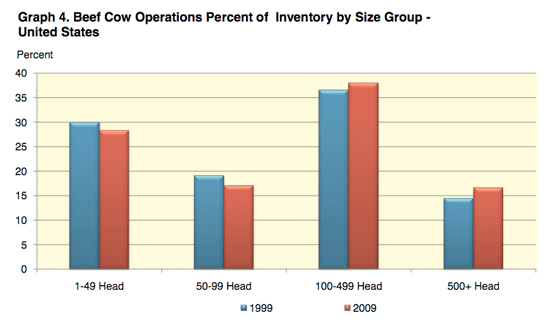
Downturn in United States Cattle Inventory Continues
Current estimates for 2010 show the Nation’s cattle herd down 1 percent from the previous year, maintaining the downturn in the current cattle cycle. Looking at the cattle inventory on a January 1 basis, this year’s decrease continues a distinct cycle of growth and liquidation that has defined the United States cattle inventory. Measured from trough to trough, the length of cycles over the last 50 years has ranged from 9 to 14 years. Recent cattle cycles have become much less pronounced, with shorter periods of increase and more prolonged phases of decrease (Graph 5).
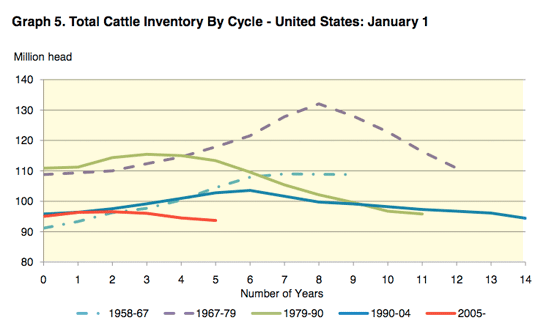
The January 1, 2010 inventory of cattle and calves, at 93.7 million, represents the third year of downturn in the cattle cycle after only three years of increase during the upturn (Graph 6).
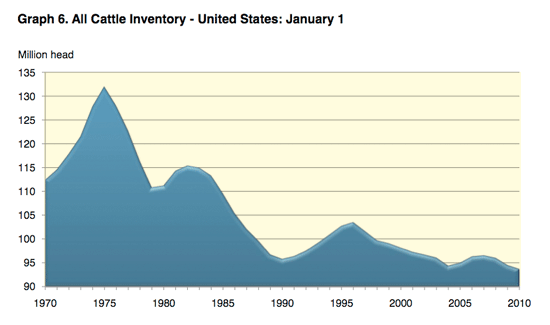
For the current cycle, total cattle inventory increased just 2.17 million head during the upturn compared with a decline of 2.87 million head during the ongoing downturn. The beef cow herd, the foundation of the total cattle inventory, has declined 1.33 million head since January 1, 2006, after gaining only 171,000 during the 2 year upturn. Since the United States cattle inventory peaked in 1975, total cattle inventory has declined 38.3 million head, or 29 percent.
The July 1, 2010, Cattle report also indicated the Nation’s cattle herd declined 1 percent to 100.8 million head. Total cattle inventory fell 1.20 million head from a year earlier with 500,000 head of the decrease coming from the beef cow herd. The July 1 beef and dairy cow herd has declined from 42.4 million head in 2006 to 40.8 million head in 2010, down 1.60 million head or 4 percent. Similarly, the calf crop declined from 37.0 million head in 2006 to an estimated 35.4 million head this year, a decline of 1.62 million head or 4 percent. Beef replacement heifers decreased 100,000 head from last year, representing a 10 percent reduction since the peak in 2006 of the most recent July cattle cycle. In July of 2005 a year prior to peak cattle inventories, beef replacement heifers represented 39.5 percent of the total of beef replacement heifers and other heifers (excluding dairy replacement heifers); five years later, they represent 36.5 percent (Graph 7). A lower percentage of beef replacement heifers would tend to indicate a leveling off or reduction of the herd.
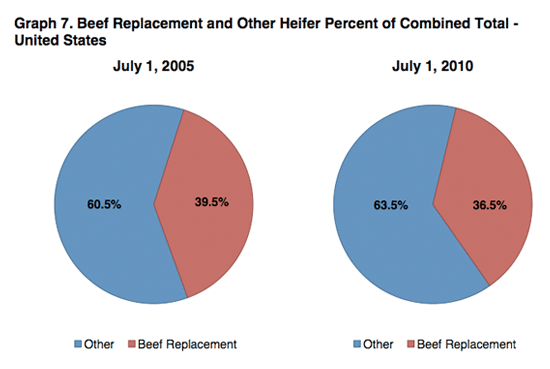
The monthly Cattle on Feed report is also useful in evaluating the current and future supplies of slaughter cattle. Each report includes estimates of total cattle on feed, placements, marketings and other disappearance from feedlots with a capacity of 1,000 or more cattle being fed for slaughter. The amount of cattle placed on feedlots throughout the year depends heavily on the supply of feeder cattle outside of the feedlots. This is generally measured by deducting the January 1 or July 1 total inventory of cattle on feed from the amount of steers, other heifers and calves on hand. The supply of feeder cattle outside of feedlots has remained relatively unchanged the past five years, totaling 27.5 million head on January 1, 2010 (Graph 8).
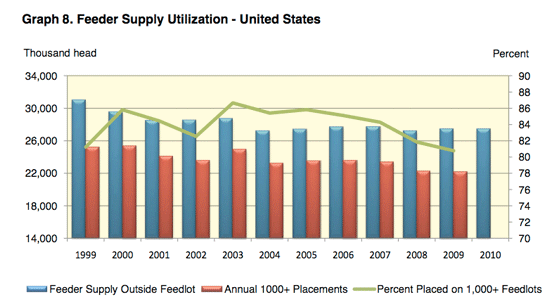
Although the supply has changed little over this time, utilization of the supply as placements on 1,000 or more capacity feedlots has fallen from 85 percent during 2006 to 81 percent for 2009. The significant increase in the price of corn over this time has challenged feedlot profitability and suppressed the amount of cattle placed in commercial feedlots through 2009 (Graph 9). On the other hand, placements of cattle on 1,000 or more capacity feedlots through November of 2010 have increased more than 4 percent from this point last year.
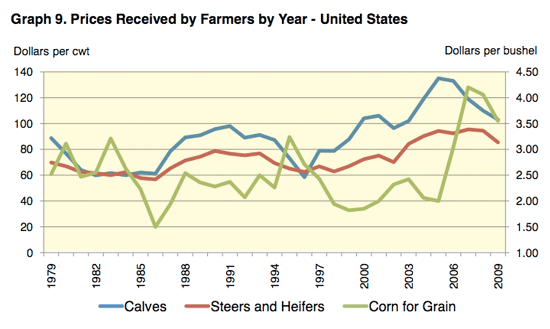
In addition to the monthly estimates, quarterly Cattle on Feed reports provide a breakdown of feedlot inventory by class. During phases of liquidation, the proportion of heifers on feed will rise due to less being retained for cow replacements. Conversely, the percentage of heifers will fall when the breeding herd is rebuilding. The October 1, 2010 Cattle on Feed report indicated that placements of heifers in feedlots remained high; suggesting that rebuilding of the breeding herd has not yet begun. For 2010, heifers have represented 37.5 percent of all cattle on feed throughout the year, up slightly from a year earlier. This compares with 34.7 percent in 2005 when the herd was rebuilding (Graph 10).
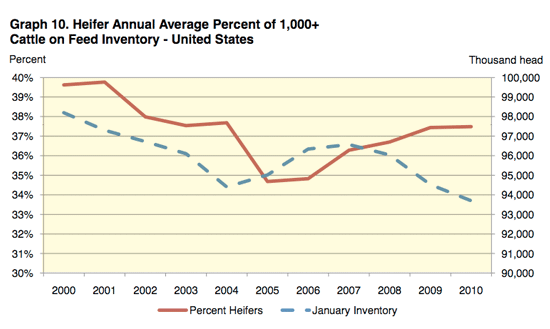
Although movement of fed cattle from feedlots to slaughter (marketings) represents a majority of cattle slaughtered in the United States, other slaughter relationships are important to consider. While heifer slaughter as a percent of total federally inspected slaughter has remained relatively unchanged over the past four years, slaughter of cows has increased 28.6 percent, making up 4 percent more of the total federally inspected cattle slaughter (Graph 11).
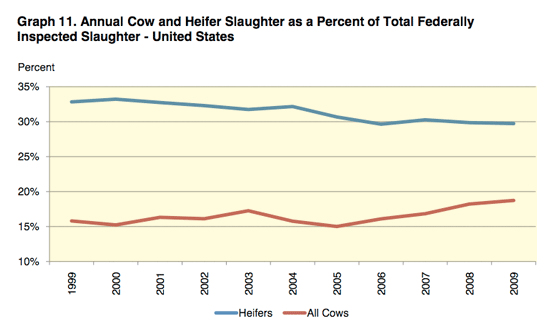
Calf slaughter as a percent of total calf crop has declined from around 8 percent in the mid-1980’s to less than 3 percent since 2000, a decline of nearly 2.5 million head (Graph 12). This decline in calf slaughter allows a corresponding number of calves to go into feedlots or the replacement herds.
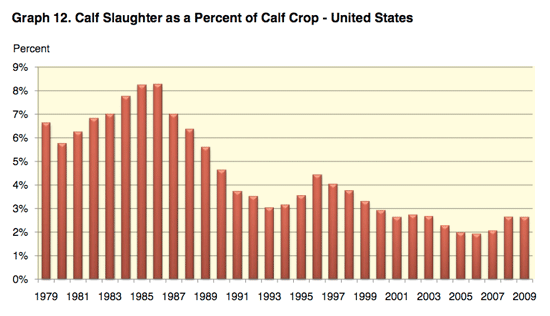
Despite the continued reduction of the United States cattle herd, beef production in the United States has actually risen over the past 30 years. Since 1979, commercial beef production has grown by 22 percent while total cattle inventory fell by 15 percent (Graph 13).
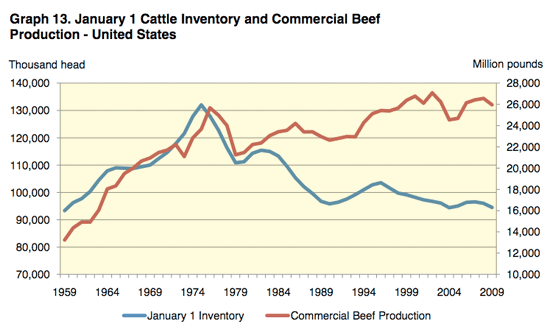
The decline in cattle inventory has been largely offset by a 23 percent increase in the average dressed weight of federally inspected cattle over this time (Graph 14). However, average live and dressed weights of cattle slaughtered during 2010 have consistently fallen below weights realized in 2009.
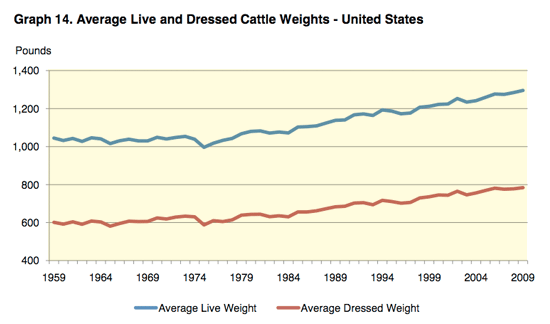
The supply of cattle in the United States is also influenced by imports and exports of live cattle. The Foreign Agricultural Service and the United States Census Bureau are the primary sources of these data. The majority of cattle imports for the United States come from Canada and Mexico. The bulk of imports from Canada are fed cattle ready for slaughter, while most of the feeder cattle are imported from Mexico. Total cattle imports in 2009 fell 282,000 head to 2.00 million head (Graph 15).
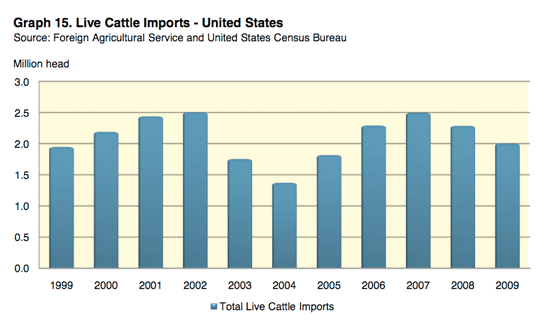
The United States exports significantly fewer cattle than it imports. Cattle exports fell to 58,000 in 2009, compared to 107,000 during 2008. Since 2000, exports of live cattle from the United States has fallen 88 percent (Graph 16). Exports declined considerably during 2003 due to trade barriers related to BSE and other diseases.
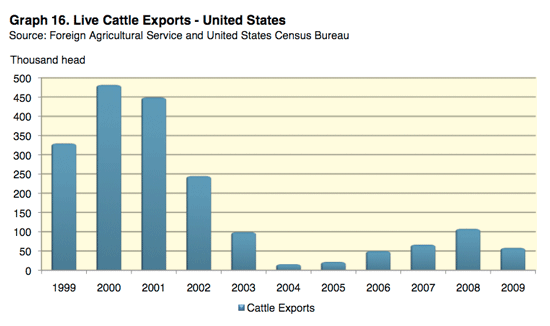
In summary, this is the third year of the downturn in the cattle cycle and there are currently no significant signs of herd expansion. Inventory of both cows and replacement heifers have been reduced in 2010 and placements of heifers in feedlots remain heavy. Growing imports of feeder cattle from Mexico have somewhat supplemented the feeder cattle supply, but with much stronger feedlot placements during 2010, supplies of feeder cattle remain extremely tight. Also considering the fact that cow slaughter remains strong, these factors appear likely to limit the ability for herd expansion in the foreseeable future.
January 2011Further Reading
| - | You can view the full report by clicking here. |


